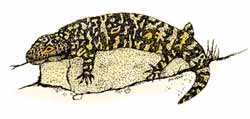|
|
|
|
|
|
Species Spotlight
on
Heloderma Suspectum

A.K.A. The Gila Monster - It is named after the Gila Basin in Arizona.
DESCRIPTION / COLORATION Heavy rotund body; Large head; Small black eyes; Short legs with big feet that have short sharp claws; Short thick tail; Forked tongue; Scales that resemble beads. Coloration = black with pink, yellow, or orange splotches and/or crossbands.
SIZE 1 to 2 feet in length; 3 to 5 pounds.
HOME North western Mexico and southern United States.
HABITAT Arid and semiarid regions in scrub and grassland.
LIFESTYLE This solitary lizard is relatively inactive. It hunts for food at twilight. It spends most of the day hidden in a burrow or under rocks. During the winter months, this animal stays in its burrow. 95% of its life is spent under ground.
DEFENSES When threatened, this lizard may inflate its body with air and hiss in an attempt to frighten off an attacker. This animal's most well known defensive trait however is surely its venomous bite. The Gila Monster is one of only two venomous lizards in the world. Its venom glands are modified salivary glands. When the animal bites, venom runs from these glands through groves in the teeth into the wound. The Gila Monster's venom has not been known to kill healthy humans, however its bite should be considered potentially fatal. In addition, the bite is very painful. This lizard's jaws are very strong. It's teeth will penetrate as much as 1/2 an inch into the victim. It is difficult to remove the Gila Monster from the object it has bitten.
FOOD The Gila Monster's diet consists of many things: mammals, birds, insects, eggs, frogs, lizards, worms, and carrion. This animal also stores fat in it's tail. It uses this fat for nourishment in the winter and other times when food is scarce.
HUNTING TECHNIQUES This lizard's sense of smell plays an important role in the finding of food. It also uses it's forked tongue to track prey animals.
BREEDING Mating takes place in early summer. The female will bury her eggs in a hole. A clutch consists of 3 to 13 eggs. The incubation period is disputed. Some sources indicate that the incubation period is 30 days while others claim that this lizard's eggs will not hatch until the following spring - 10 months.
LIFE SPAN 20 years.
IN CAPTIVITY These animals adapt well to captivity under pristine conditions. SOME REQUIREMENTS: Burrowing area; Day temperature = 75-85 degrees F. with a basking area up to 90 degrees F; Water bowl large enough for the animal to lie in.
SPECIAL CONCERNS The Gila Monster is currently threatened by habitat destruction. In the past, its numbers were greatly diminished by their removal from the wild into the pet trade.
INTERESTING FACTS There are several myths associated with the Gila Monster. Certain groups of Native Americans believed that it had magical powers and was immortal. Paralleling this historical mystique, there is a surprising amount of current day information about the Gila Monster that contradict each other.
For more info:
Gila Monsters & Beaded Lizards - Helodermatidae
And these other Web sites: